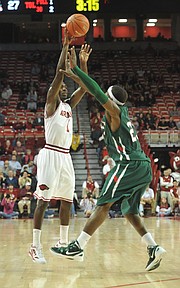HOUSTON-Shovels and flashlights in hand on a night in mid-February, investigators restarted the search nearly two decades after the girls went missing.
It would end about six weeks later, with two of the largest excavation sites for human remains ever, forensic anthropologist experts said, a demonstration of effort by multiple agencies and community members to find Kelli Ann Cox and Jessica Cain. Both disappeared in the summer of 1997.
While the Texas Rangers have led the criminal investigation, the Friendswood Police Department oversaw the excavation operation at sites in Brazoria County and Houston-from digging methods to flying in specialized dogs from California to enlisting help from volunteers who donated construction equipment.
The FBI, La Marque and Denton police departments, and Brazoria County and Galveston County sheriff's offices, along with Texas Equusearch, a nonprofit dedicated to finding missing people, also helped at the sites.
Friendswood police Capt. Josh Rogers, who coordinated excavation efforts at both sites, remembers an outpouring of community involvement in the initial searches in 1997, when Cain vanished and Laura Smither, a 12-year-old Friendswood girl, disappeared and was later found dead.
"What's kind of interesting is that's the way it happened over the past couple of months, too," Rogers told The Galveston County Daily News .
Rogers and those who donated time and resources to the recovery of Cox and Cain were scheduled to be recognized at a Friendswood City Council meeting.
On Feb. 15, investigators and William Lewis Reece, a convicted kidnapper serving a 60-year prison sentence, went to a field off state Highway 288 and County Road 51 in Brazoria County. Earlier that day, Reece had been released from prison in Huntsville on a bench warrant to assist in the investigation. They didn't plan to find anything as the evening grew dark, but law enforcement needed to move quickly after an interview with Reece, Rogers said.
"When someone is cooperating, you want to adjust your schedule to theirs," he said. "You do it when they're ready to cooperate."
A multiyear investigation in Oklahoma led to that first night of digging in Brazoria County. In September, prosecutors in Oklahoma County had charged Reece with murder and kidnapping in the July 1997 death of 19-year-old Tiffany Johnston, whose body was found alongside a road in Canadian County, Okla., which borders Oklahoma County.
Oklahoma investigators and the Friendswood Police Department have been communicating since August 2014, Police Chief Bob Wieners said. Oklahoma law enforcement requested information from Friendswood police, who had a timeline of Reece's whereabouts in 1997 because the agency had investigated the death of Smither, Wieners said.
For years, investigators have considered Reece a "person of interest" in the deaths of both Smither and Cain.
Initially, investigators searched the rough terrain of the Brazoria County field, using shovels, a small track hoe and small excavator. It became clear the search would take more than a few hours or couple of days, Rogers said. Eventually, the field in Brazoria County would yield the bones of Cox, a 20-year-old woman who disappeared from Denton in July 1997.
But after the first week of unsuccessful searching, the multiagency team moved its operation to a horse pasture about 30 miles north in Houston to search for Cain.
The Houston search began with Reece pointing to specific areas on the ground, Rogers said. But in the last two decades, the site has changed; the property had been divided into three parcels, and structures and fence lines were moved, Rogers said. Overlaying aerial photography from 1997 on top of images from the current layout, investigators tried to narrow down a location. They also used cadaver dogs and ground-penetrating radar.
But the strategy changed to a systematic "strip-mining" technique over a 75,000-square-foot area-significantly larger than the size of a football field. In some places, they dug as deep as 8 feet. By the fourth week of searching, a movement was underway to borrow larger excavators from construction contractors in the area.
Mark Boyer, who owns Houston-based Boyer Inc., donated equipment.
"It was quite an endeavor-like looking for a needle in a haystack," Boyer said. "I know it's tough on budgets, and these people have limited resources."
Because the normal cadaver dogs didn't turn up anything, California-based Institute for Canine Forensics sent two border collies and their owners to search the site. The dogs are trained to detect the scent of human bones buried for many years. A local resident who works for Southwest Airlines donated plane tickets to fly them from across the country, and business owners paid for lodging during their five-day stay, Wieners said.
However, the dogs were unable to detect any remains. It was methodical digging that eventually completed the search.
"We were looking at every bucket and had been for weeks on end, thinking that every bucket was going to be the one where we located something," Rogers said.
After 25 days of digging in Houston, a La Marque police officer spotted what appeared to be bones in an excavator bucket pulled from the ground on the afternoon of March 18. The Harris County Institute of Forensic Sciences confirmed the remains were human and recovered the bones from the ground. On April 14, the University of North Texas Health Science Center confirmed they belonged to Cain.
In the meantime, the multiagency team returned to Brazoria County, where they found remains confirmed to be Cox's on April 1.
Harrell Gill-King directs the laboratory of forensic anthropology at the Center for Human Identification at the University of North Texas. The center houses the FBI's nationwide DNA database, a nationwide missing-person database and the forensic anthropology lab.
Gill-King, who helped law enforcement during the investigation, called the size of the search areas "stunning." He compared it to the size of archaeological dig sites the Middle East or mass graves from military conflicts in South America.
Additionally, the high clay content of the soil-sometimes called black gumbo-doesn't drain well, making it difficult to search, he said.
"I've rarely seen that kind of motivation," he said. "They were going to find her or else."
No charges have been filed against Reece in the deaths of Cox, Cain or Smither.
Galveston County District Attorney Jack Roady said his prosecutors continue to coordinate the investigation with Brazoria, Denton and Oklahoma counties. Roady has said any charges related to Cain's death would be prosecuted in Galveston County.
Oklahoma County First Assistant District Attorney Scott Rowland, whose office charged Reece with murder and kidnapping, has said that Texas officials asked whether Reece could avoid the death penalty if he led investigators to Cain's remains. The office made no such promises and would have no decision on seeking the death penalty against Reece until he is extradited to Oklahoma for his arraignment in Johnston's killing, Rowland said.
Investigators have been gathering evidence from the past 19 years, and they're wrapping up that process, Roady said. However, Roady did not disclose a potential timeline for when charges would be filed.


